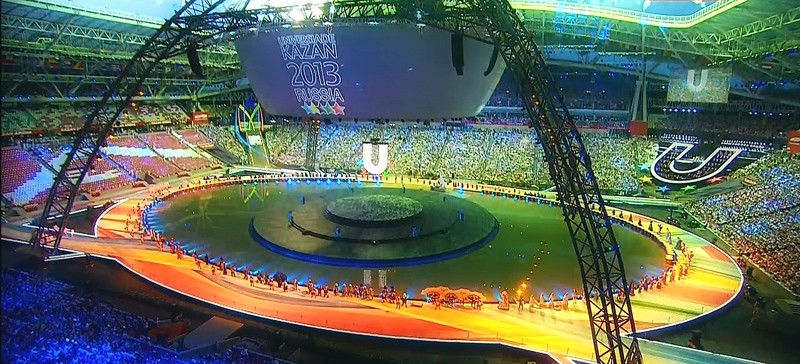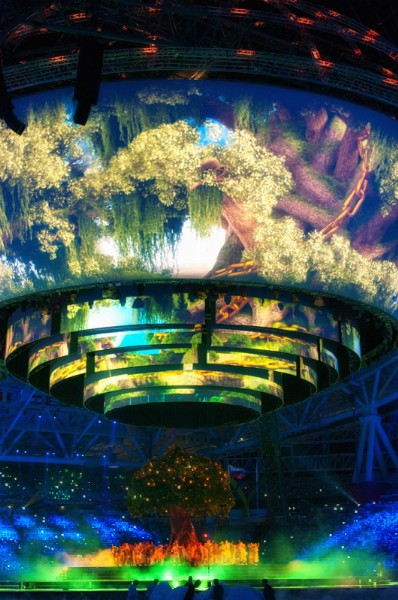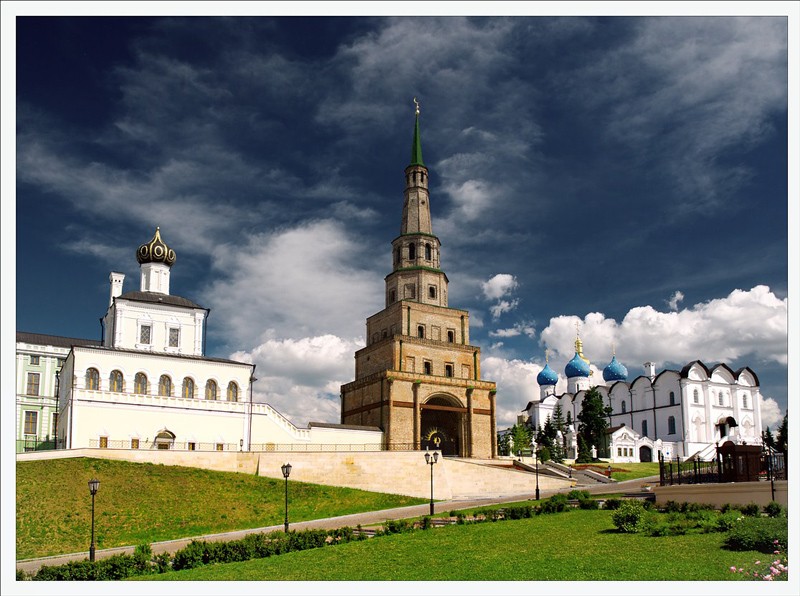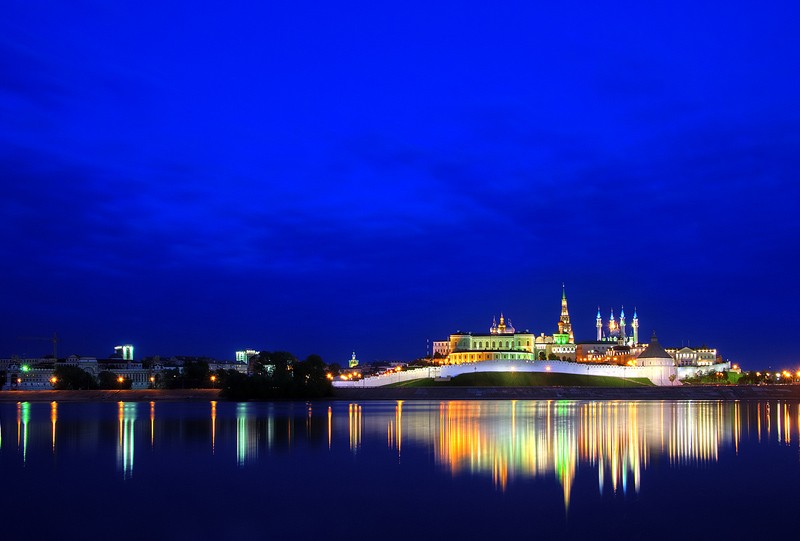The Republic of Tatarstan
The Republic of Tatarstan, part of the Russian Federation, is located in the Volga Federal District at the confluence of the two great rivers of the Volga and the Kama, about eight hundred kilometres from Moscow.
A far-ranging project, from the airport to the heart of the city
With the new millenium the city has been literally transformed, its historical city centre and famous Kremlin have both been given an extensive face lift and restored to their full former glory. When the 2013 Summer Universiade games were held in Kazan from 6 to 17 July, the city drove its reconstruction programme even further forward and entrusted Italian experts Paghera with landscaping and renewing its parks, gardens and avenues. This was a huge project, involving a vast slice of the city, from the international airport to the centre of the town and including the whole district around the stadium. A complex, wide-ranging operation which had to be both macro- and micro-managed, revamping parks, gardens, tree-lined avenues and roundabouts, right down to the single details in individual flowerbeds. The first step was a detailed analysis of the setting and its environmental constraints, to decide what species of plants would adapt better to a climate with a temperature range of – 40 °C in winter to + 30°C in summer. The choice and juxtaposition of the plants, shrubs and flowers was also important to create a sort of “green screen” able to conceal and soften the rather harsh forms of the residential apartment blocks built under the former Soviet regime.
A far-ranging project
After this initial analysis the Paghera team drafted a number of different ideas and put them forward to the city council, who chose the one they felt to be most suitable for their needs.
The urban planning and landscaping department of the local authorities were extremely cooperative , providing Paghera with a thousand-strong workforce to realise the project under the careful supervision of the Italian experts.
The only problem was the language barrier because, unusually, local gardeners used their native Cyrillic script for plant denomination rather than the universal so-called Botanical Latin. This handy international code usually ensures that plants can safely be identified without error from New York to Rome or Peking.
Problem solved
But the issue was solved in the end by the simple expedient of drawing pictures, in what proved to be an effective strategy for ensuring the smooth running of the project in its many phases. For example a series of blueprints described in very precise detail the procedure for planting out trees, made the language barrier immaterial.
To create an instant garden city in full bloom in just a few months, as was necessary on this occasion, roughly a million mature plants and trees, some of them up to 11 metres tall, were sourced from nurseries and garden centres and replanted around Kazan. The organising committee did not feel it was necessary to source the trees and plants all the way from Italy; 17% of Tatarstan is forested, so it was decided to use trees from the native woods and replant them in Kazan. Unfortunately they all died. Three separate attempts were made, each one doomed to exasperating and tragic failure. When faced with the evidence, the committee realised that trees do in fact have to be conditioned in nurseries before being replanted elsewhere. To obtain large trees which will thrive for landscaping projects, they have to be grown in open fields but uprooted, preserving the clod of earth around the roots to protect them, and replanted two or three metres away every one or two years. This procedure ensures the roots do not penetrate deeply into the earth but remain circumscribed and protected, so that the trees can easily be uprooted, transported and replanted on the site where they are required without damage, and with a much better chance of success than if they are sourced directly from the wild. These trees, like the flowers, were in part sourced from nurseries the company had set up in various parts of eastern Europe, among them a splendid, and very popular, garden centre specialising in roses and peonies.
Undeterred by the unfortunate episode of the dying trees, the whole city turned out to plant the shrubs. Led by the mayor in person, children, students and even the army, all weighed in to help, almost as if it had been a national holiday.
6 July 2013
Having worked extremely hard for six months in weather conditions that were sometimes far from ideal, having planted millions of plants and flowers such as peonies, roses and lilac, and having turfed thousands of square metres with immaculate lawns specially grown elsewhere, the city was all ready for the inauguration day of the Games on 6 July with its whirl of dances, parades and wonderful firework displays. The Universiade Games finished eleven days later, but the new gardens, the parks and the flowering avenues created for the occasion remained, permanently altering the face of the city.
The Republic of Tatarstan, part of the Russian Federation, is located in the Volga Federal District at the confluence of the two great rivers of the Volga and the Kama, about eight hundred kilometres from Moscow.
A far-ranging project, from the airport to the heart of the city
With the new millenium the city has been literally transformed, its historical city centre and famous Kremlin have both been given an extensive face lift and restored to their full former glory. When the 2013 Summer Universiade games were held in Kazan from 6 to 17 July, the city drove its reconstruction programme even further forward and entrusted Italian experts Paghera with landscaping and renewing its parks, gardens and avenues. This was a huge project, involving a vast slice of the city, from the international airport to the centre of the town and including the whole district around the stadium. A complex, wide-ranging operation which had to be both macro- and micro-managed, revamping parks, gardens, tree-lined avenues and roundabouts, right down to the single details in individual flowerbeds. The first step was a detailed analysis of the setting and its environmental constraints, to decide what species of plants would adapt better to a climate with a temperature range of – 40 °C in winter to + 30°C in summer. The choice and juxtaposition of the plants, shrubs and flowers was also important to create a sort of “green screen” able to conceal and soften the rather harsh forms of the residential apartment blocks built under the former Soviet regime.
A far-ranging project
After this initial analysis the Paghera team drafted a number of different ideas and put them forward to the city council, who chose the one they felt to be most suitable for their needs.
The urban planning and landscaping department of the local authorities were extremely cooperative , providing Paghera with a thousand-strong workforce to realise the project under the careful supervision of the Italian experts.
The only problem was the language barrier because, unusually, local gardeners used their native Cyrillic script for plant denomination rather than the universal so-called Botanical Latin. This handy international code usually ensures that plants can safely be identified without error from New York to Rome or Peking.
Problem solved
But the issue was solved in the end by the simple expedient of drawing pictures, in what proved to be an effective strategy for ensuring the smooth running of the project in its many phases. For example a series of blueprints described in very precise detail the procedure for planting out trees, made the language barrier immaterial.
To create an instant garden city in full bloom in just a few months, as was necessary on this occasion, roughly a million mature plants and trees, some of them up to 11 metres tall, were sourced from nurseries and garden centres and replanted around Kazan. The organising committee did not feel it was necessary to source the trees and plants all the way from Italy; 17% of Tatarstan is forested, so it was decided to use trees from the native woods and replant them in Kazan. Unfortunately they all died. Three separate attempts were made, each one doomed to exasperating and tragic failure. When faced with the evidence, the committee realised that trees do in fact have to be conditioned in nurseries before being replanted elsewhere. To obtain large trees which will thrive for landscaping projects, they have to be grown in open fields but uprooted, preserving the clod of earth around the roots to protect them, and replanted two or three metres away every one or two years. This procedure ensures the roots do not penetrate deeply into the earth but remain circumscribed and protected, so that the trees can easily be uprooted, transported and replanted on the site where they are required without damage, and with a much better chance of success than if they are sourced directly from the wild. These trees, like the flowers, were in part sourced from nurseries the company had set up in various parts of eastern Europe, among them a splendid, and very popular, garden centre specialising in roses and peonies.
Undeterred by the unfortunate episode of the dying trees, the whole city turned out to plant the shrubs. Led by the mayor in person, children, students and even the army, all weighed in to help, almost as if it had been a national holiday.
6 July 2013
Having worked extremely hard for six months in weather conditions that were sometimes far from ideal, having planted millions of plants and flowers such as peonies, roses and lilac, and having turfed thousands of square metres with immaculate lawns specially grown elsewhere, the city was all ready for the inauguration day of the Games on 6 July with its whirl of dances, parades and wonderful firework displays. The Universiade Games finished eleven days later, but the new gardens, the parks and the flowering avenues created for the occasion remained, permanently altering the face of the city.












